
As per the report, India’s trade dependence on China and the EU increased 1.2% each in 2023 while it reduced 0.6% on Saudi Arabia. Trade interdependence between China and the US decreased further in 2023.
“Quarter-over-quarter statistics indicate return to growth in some major economies, including China and India,” UNCTAD said.
As per the report, towards the end of 2023, trade in goods saw growth in several major economies, including China with a 5% rise in imports) and India with a 5% growth in exports.
The fourth quarter of 2023 marked a departure from previous quarters, with both merchandise and services trade stabilizing quarter-over-quarter.
“Developing countries, especially those in the African, East Asian and South Asian regions, experienced growth in trade during this period,” UNCTAD said.In 2023, global trade saw a 3% contraction, equaling roughly $1 trillion, compared to the record high of $32 trillion in 2022. Despite this decline, the services sector showed resilience with a $500 billion, or 8%, increase from the previous year, while trade in goods experienced a $1.3 trillion, or 5%, decline compared to 2022.South-South trade, or trade between developing economies, saw a steeper decline of about 7% in 2023 but these trends reversed in the last quarter of 2023, with developing countries and South-South trade resuming growth while trade in developed countries remained stable.
2024 outlook
Going ahead, UNCTAD said that the first quarter of 2024 suggests a continued improvement in global trade, especially considering moderating global inflation and improving economic growth forecasts.
“Additionally, rising demand for environmental goods, particularly electric vehicles, is expected to bolster trade this year,” it said cautioning that the geopolitical tensions and supply chain disruptions persist as pivotal factors influencing bilateral trade trends and require ongoing scrutiny.
Disruptions in shipping routes particularly those related to security issues in the Red Sea and the Suez Canal, as well as adverse climate effects on water levels in the Panama Canal, carry the potential to escalate shipping costs, prolong voyage times and disrupt supply chains, according to UNCTAD.






